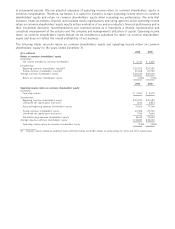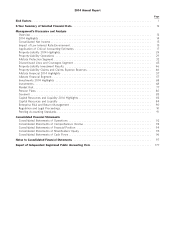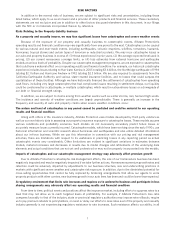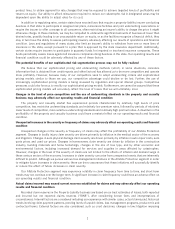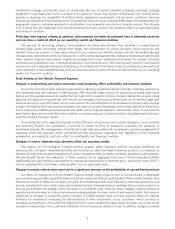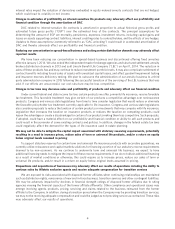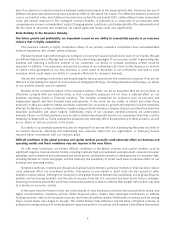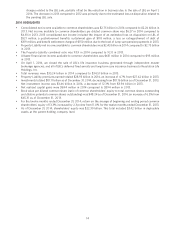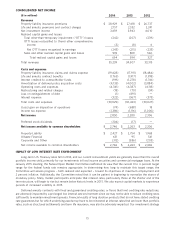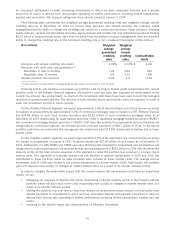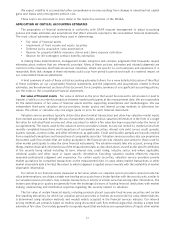Allstate 2014 Annual Report Download - page 107
Download and view the complete annual report
Please find page 107 of the 2014 Allstate annual report below. You can navigate through the pages in the report by either clicking on the pages listed below, or by using the keyword search tool below to find specific information within the annual report.launched a quantitative easing program and several central banks have lowered their benchmark interest rates to
stimulate economic activity. The diverging policies are likely to result in higher volatility and less certainty in capital
markets.
General economic conditions could adversely affect us in the form of consumer behavior and pressure investment
results. Consumer behavior changes could include decreased demand for our products. For example, if consumers
purchase fewer automobiles, our sales of auto insurance may decline. Also, if consumers become more cost conscious,
they may choose lower levels of auto and homeowners insurance. In addition, holders of some of our interest-sensitive
life insurance and annuity products may engage in an elevated level of discretionary withdrawals of contractholder
funds. Our investment results could be adversely affected as deteriorating financial and business conditions affect the
issuers of the securities in our investment portfolio.
Losses from legal and regulatory actions may be material to our operating results, cash flows and financial
condition
As is typical for a large company, we are involved in various legal actions, including class action litigation
challenging a range of company practices and coverage provided by our insurance products, some of which involve
claims for substantial or indeterminate amounts. We are also involved in various regulatory actions and inquiries,
including market conduct exams by state insurance regulatory agencies. In the event of an unfavorable outcome in one
or more of these matters, the ultimate liability may be in excess of amounts currently accrued and may be material to
our operating results or cash flows for a particular quarter or annual period and to our financial condition. The aggregate
estimate of the range of reasonably possible loss in excess of the amount accrued, if any, disclosed in Note 14 of the
consolidated financial statements is not an indication of expected loss, if any. Actual results may vary significantly from
the current estimate.
We are subject to extensive regulation and potential further restrictive regulation may increase our operating costs
and limit our growth
As insurance companies, broker-dealers, investment advisers and/or investment companies, many of our
subsidiaries are subject to extensive laws and regulations. These laws and regulations are complex and subject to
change. Changes may sometimes lead to additional expenses, increased legal exposure, and additional limits on our
ability to grow or to achieve targeted profitability. Moreover, laws and regulations are administered and enforced by a
number of different governmental authorities, each of which exercises a degree of interpretive latitude, including state
insurance regulators; state securities administrators; state attorneys general and federal agencies including the SEC, the
FINRA and the U.S. Department of Justice. Consequently, we are subject to the risk that compliance with any particular
regulator’s or enforcement authority’s interpretation of a legal issue may not result in compliance with another’s
interpretation of the same issue, particularly when compliance is judged in hindsight. In addition, there is risk that any
particular regulator’s or enforcement authority’s interpretation of a legal issue may change over time to our detriment,
or that changes in the overall legal environment may, even absent any particular regulator’s or enforcement authority’s
interpretation of a legal issue changing, cause us to change our views regarding the actions we need to take from a legal
risk management perspective, thus necessitating changes to our practices that may, in some cases, limit our ability to
grow or to improve the profitability of our business. Furthermore, in some cases, these laws and regulations are designed
to protect or benefit the interests of a specific constituency rather than a range of constituencies. For example, state
insurance laws and regulations are generally intended to protect or benefit purchasers or users of insurance products,
not holders of securities, which is generally the jurisdiction of the SEC, issued by The Allstate Corporation. In many
respects, these laws and regulations limit our ability to grow or to improve the profitability of our business.
Regulatory reforms, and the more stringent application of existing regulations, may make it more expensive for us
to conduct our business
The federal government has enacted comprehensive regulatory reforms for financial services entities. As part of a
larger effort to strengthen the regulation of the financial services market, certain reforms are applicable to the insurance
industry, including the FIO established within the Treasury Department.
In recent years, the state insurance regulatory framework has come under public scrutiny, members of Congress
have discussed proposals to provide for federal chartering of insurance companies, and the FIO and FSOC were
established. In the future, if the FSOC were to determine that Allstate is a ‘‘systemically important’’ nonbank financial
company, Allstate would be subject to regulation by the Federal Reserve Board. We can make no assurances regarding
the potential impact of state or federal measures that may change the nature or scope of insurance and financial
regulation.
7



